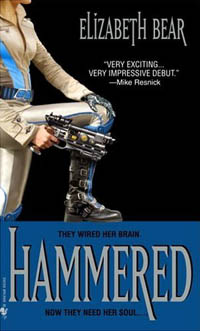
 |
HammeredBeyond the Usual Cyberpunk Clichés |
Title: Hammered
Author: Elizabeth Bear
Publisher: Bantam Spectra
Vital Stats: © 2005; paperback, 324 pp.; US$6.99, CAN$10.99
ISBN: 0-553-58750-1
Freak Nation Rating: ![]()
![]()
![]()
![]()
Buy It From: Powell’s Books
With her debut, novelist Elizabeth Bear has managed to score quite a publishing coup: her first novel, Hammered, is also the first in a trilogy. (The followup volumes, Scardown and Worldwired, were published shortly after Hammered.) Indeed, it’s quite possible that Bear’s work is “a trilogy” only in the (mistaken) sense that the word is sometimes applied to Lord of the Rings: a single story that was originally published in three volumes instead of one. Certainly the ending is abrupt enough to suggest that the volumes were never really intended to be separated.
The story deftly interweaves the paths of several main characters, particularly: Jenny Casey, a Québecois part-Mohawk ex-Special Forces operative whose cyber-implants make her invaluable to a top-secret project; Dr. Elspeth Dunsany, a researcher in artificial intelligence who’s just been released from a long prison sentence; Gabriel Castaign, who saved Jenny’s life in the incident that cost her an arm, an eye, and some of her sanity; and Razorface, the gang leader whose loyalty is getting him involved in something much bigger than he’s ever dealt with before. There’s also one of the odder and better-drawn characters in recent science fiction: an AI based on the personality of Dr. Richard Feynman, who’s escaped from his original project and is in hiding in the Net.

These characters exist in a world that projects current trends into the future in a way that makes perfect cyberpunk sense, but hasn’t been seen much before. Bear (no relation to any other famous sci-fi authors) paints the picture deftly and without slamming the reader with any long chunks of exposition. The United States has been rendered irrelevant by decades of fundamentalist government; Canada is in ascendance and has bases on the Moon and Mars, while China’s power continues to grow. Most of the standard cyberpunk themes and props are easy to find; indeed, you’ve no doubt already spotted a half-dozen just in the character descriptions. But Bear moves effortlessly beyond the stereotypes to explore their ramifications in depth.
For example, everyone who’s played Cyberpunk 2020 or Shadowrun knows the usual tropes about the hotwired solo or street samurai whose combat reflexes are jacked up to a fever pitch. But where teenaged gamers use that cliché to posture and swagger about whose character is “badder” than whose, Bear instead sucks us into the head, into the life experience, of such a combat vet. When a friend makes an unexpected gesture, we experience Jenny’s hotwired reactions as the world slows to a crawl and action outstrips perception. Bear makes us understand that combat reflexes are no game, and doesn’t forget to show us the aches and pains and late-night drinking sessions that follow on a lifetime of combat experience. For sheer realism, Jenny Casey has Molly Millions beat hands-down.
Hammered’s plot also slips outside the usual bounds of a cyberpunk plotline, exploring territory more often reserved for other sci-fi subgenres. These excursions (about which I don’t want to give too many specifics, to avoid spoiling plot elements) are a bit less seamless; they initially jar the reader a bit into wondering just what sort of story Ms. Bear is telling here. By the end of the book, it seems as if these disparate elements are likely to jell as the story continues — likely by the middle of the second book — but they haven’t gotten a chance to quite finish the process yet.
Indeed, that abrupt ending is the book’s weakest part, and it may well be publisher-mandated. The ending resolves practically nothing, involves no cliffhangers or other hooks, and feels more like a chapter break than the end of a book. Reading the final 30 or so pages of Hammered reminded me of nothing so much as the final pages of Neal Stephenson’s The Diamond Age — not because there’s any similarity in their plot structures at all, but simply because both involved a lot of looking dubiously at the steadily decreasing number of pages left before the back cover, and the increasing sense that the author couldn’t possibly resolve all the plot threads in so little space. In both cases, the reader turns out to be quite right, but at least in Hammered, there’s the slightly relieving revelation that Bear never intended to resolve the plot; that, apparently, will wait for the next two books.
I’m assuming that Bantam Spectra made the choice to release this story in three parts, probably on the logic that readers would never buy a 1000-page book by an unknown, first-time author. However, they played a cruel trick on readers by giving no clues on the cover that this is only one-third of a story, not the full thing. (The alternative, extremely unlikely, explanation is that Ms. Bear is a protegé of Stephenson’s, and has inherited his abysmal ending- and- denouement skills.)
By the time the curtain closes on Hammered, Ms. Bear has quite a few balls in the air, of varying (but mostly high) complexity. Though there’s ample room for her to drop them catastrophically in the following two volumes, she’s handled them well enough so far that I’m willing to trust that the rest of the ride will be worth it. In a way, reviewing Hammered in isolation is somewhat unfair, as it’s only the first third of Bear’s full story. A review of, for example, only the first third of Neuromancer (say, just the Chiba and Sprawl sections), would probably suffer at least as poorly by comparison.
Kai MacTane is the Freak Nation’s webmaster, and has been reading science fiction in the mold of Hammered since he was old enough to read. He used to want to write the stuff, too, until he realized he’d be much better suited to writing computer programs and running Web sites. He used to play a hotwired elven street-sam in Shadowrun.